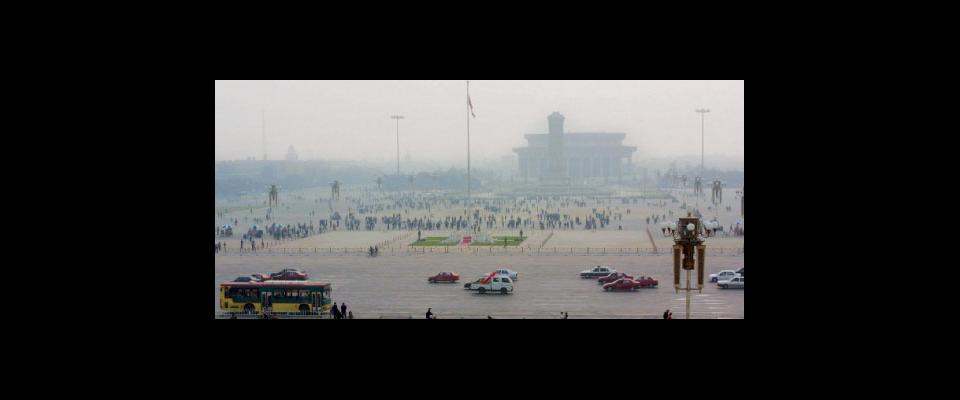While visiting Beijing this past spring, I found myself gazing up at the city’s impressive high-rise landscape one morning and suddenly realizing that I had seen neither the sun nor the sky since arriving. The natural tendency is to explain such a vanishing act as due to inclement weather or some other unique atmospheric condition. The reality is, however, that the penumbra that hangs so persistently over most Chinese cities is man-made.
This April I set off in a van with my Chinese–born wife, a close friend, and our two boys (who were at school in Beijing) on a vacation-time expedition across North China’s Shanxi Province to visit some Buddhist temples and grottoes and an ancient walled town.
Having visited many provincial cities over the more than three decades I have been traveling to China, I was well-acquainted with their gritty industrial charmlessness, which can be so unrelieved in its bleakness as to make one forget that such a thing as natural beauty can exist in an urban environment. I knew that Shanxi was coal country: 70 percent of China’s energy comes from burning this fossil fuel, meaning that China uses more coal each year than the U.S., the E.U., and Japan combined. So rapidly is the demand for energy increasing that experts believe annual coal production increased by 14 percent over the past two years. But even with this knowledge, I was still completely unprepared for what we found in Shanxi.
The first revelation was that, even after we had left Beijing, passed through the Great Wall, and gained the countryside beyond, the yellow of the sun and the blue sky remained stubbornly obscured. In fact, during the whole thousand-mile trip, the sky remained a persistent, fluorescent gray. And, save for a suggestion of color in the yellow loess earth of the region or the occasional dash of color offered by drifts of plastic bags that littered the roadsides, the Shanxi landscape looked as if it had been photographed out of focus in black and white.
The highways were an endless crawl of large, battered, and overloaded coal trucks, grinding sluggishly up hills and then hurtling down into valleys. The roadsides were relieved by occlusions of tin shacks and one-story brick lean-to structures occupied by greasy mechanics and tire repair shops, sooty outdoor restaurants, and truck stops where drivers could get a quick and inexpensive meal, a short nap, and maybe a local woman. Their earthen parking areas were drenched in waste motor oil, hydraulic fluid, solvents, and God knows what other toxic petroleum by-products. Living trees were few, but everywhere were wrecked vehicles, piles of fly ash and rubble, and of course, mountains of coal from the thousands of state-owned and privately run mines, many of them primitive, dangerous, illegal, and with some of the most appalling work conditions in the world today. And then, farther back from the roads were the voracious industrial users of this “black gold”—power plants belching clouds of bituminous brown smoke up into the exhausted air and cement factories with great plumes of white dust billowing up from the piles of kiln-cooked limestone like snow off the face of Mt. Everest.
As we drove toward Taiyuan and Datong, two of the most polluted cities in the world (China has 16 of the top 20 contenders for this dubious honor, and 4 of the top 10 are in Shanxi Province), we crossed bridges over rivers—or perhaps it would be more accurate to say riverbeds because, with rare exception, they were all bone-dry. North China admittedly has been experiencing a severe drought these past few years, but the destruction of China’s rivers is not caused by drought alone. Uncontrolled construction of dams and overuse of riparian water have dried up hundreds of North China rivers, or left them as little more than sewers flowing with industrial effluent and human waste.
In fact, even the mighty Yellow River that once repeatedly flooded millions of acres as it flowed down from its high-altitude watershed on the Tibetan Plateau until it crossed the flat North China Plain, where it became known as “China’s Sorrow,” has ceased to flow at its lower reaches. Now, because of diminished glaciers, extensive damming, and overuse of its flow for irrigation and industry, the river commonly ceases to flow in the summer and fall altogether, long before it should debouch into the Yellow Sea. That this once legendary river system should now have dwindled to a seasonal trickle is both a new kind of sorrow for China and a cautionary casualty of how this country’s dynamic rate of economic growth has led to rampant exploitation and destruction of its already strained natural-resource base.
If one travels from city to city by plane, it is easy to assume that one has perhaps just arrived on a bad day—that the polluted air and even the dried-up rivers and despoiled land are something of an exception to the rule. But when one drives hundreds of miles from city to city, it becomes inescapably clear that China is on the precipice of an environmental implosion the likes of which our world has yet to experience.
The simple truth is this: The enormous cost that China is paying for its impressive development is not reflected in its 9–10 percent average annual growth rate. It is, however, abundantly evident for anyone who cares to notice the country’s polluted air (sulfur dioxide emissions are estimated to cause some 400,000 premature deaths each year); contaminated rivers and lakes (75 percent of river water flowing through urban areas is unsuitable for municipal water systems or even fishing); ravaged forests (wooden chopsticks alone devour some 70.6 million cubic feet of timber annually); overgrazed grassland (90 percent of which are facing desertification and degradation); and polluted coastal habitat (grossly polluted by those toxic rivers that do make it to the sea).
“The conflict between environment and development is becoming ever more prominent,” a report from the State Council (China’s Cabinet) recently warned. “The relative shortage of resources, fragile ecology, and insufficient environmental capacity are becoming critical problems hindering China’s development.”
Nowhere is this contradiction more evident than in Shanxi Province, the heart of China’s coal-fired industrial revolution.
As Zhu Guangyao, Deputy Chief of the State Environmental Protection Administration, recently put it, China’s environmental situation is worsening and “allows for no optimism.”
Orville Schell is the dean of Berkeley’s Graduate School of Journalism and the author of 14 books, 9 of which relate to China.
From the September October 2006 Global Warning issue of California.



















